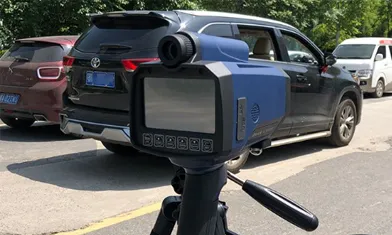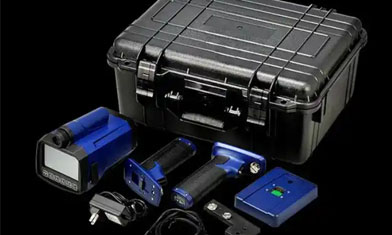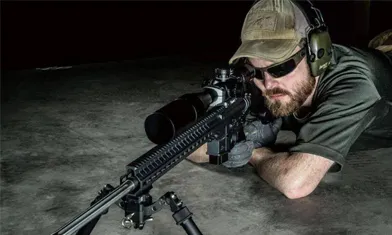Application of infrared thermal imager in aiming through walls
Infrared thermal imagers generate images by capturing infrared radiation (heat) emitted by objects, eliminating the need for visible light. This makes them particularly advantageous in low-visibility environments, such as at night and in foggy conditions. When combined with the need for "through-wall targeting," these cameras must overcome the infrared signal attenuation limitations of ordinary walls and achieve "through-wall detection + targeting" capabilities in specific scenarios through technical optimization. The following is a core analysis:
I. The Technical Logic of Infrared Thermal Imagers' "Through-Wall" Capabilities
(I) Essential Differences from Traditional Wall-Penetrating Technologies
Ordinary infrared thermal imagers (such as those used for civilian temperature measurement and conventional security) cannot penetrate solid brick or concrete walls. These walls have high density and poor thermal conductivity, absorbing or reflecting over 90% of infrared radiation. Consequently, infrared signals from targets behind these walls cannot effectively penetrate and be captured by the detector.
An infrared thermal imager with the potential to penetrate walls must meet two key requirements:
Compatible with low-attenuation wall types: It can only penetrate thin, low-density obstacles such as single-layer wood (less than 5cm thick), plastic sheets, glass, and thin gypsum boards. These materials offer low infrared radiation resistance and allow some heat signals to pass through (for example, a 2cm-thick pine board can pass 30%-40% of the infrared signal from a person behind the wall).
Equipped with a high-sensitivity detector: Using an infrared detector with a resolution of ≥640×512 and a pixel pitch of ≤12μm (such as a vanadium oxide VOx detector), combined with a high-gain signal amplification circuit, it can capture subtle differences in infrared radiation after penetration and restore the outline (but not the details) of the target behind the wall. (II) Technical Adaptation for "Penetration + Aiming"
To achieve aiming functionality, the device must add the following features to its infrared imaging system:
Target Locking Algorithm: This uses AI to identify the thermal profile of targets behind walls (such as humans or heat-generating equipment), automatically marks the center point (aiming point), and filters out thermal interference from the wall itself (such as wall seams and heat dissipation points in pipes);
Crosshair Overlay: This overlays an electronic crosshair onto the infrared display, allowing manual adjustment of the aiming position. Some professional models can also integrate a laser ranging module (with a range of 5-50 meters) to calculate the distance between the aiming point and the device, assisting in determining trajectory or movement path;Multi-Mode Switching: This device supports one-touch switching between "conventional thermal imaging" (without wall penetration enhancement) and "penetration enhancement mode." The latter enhances the analysis of penetration signals by increasing detector sensitivity and reducing image noise. (For example, a certain military model in penetration enhancement mode can detect a person standing or lying behind a 3cm thick wooden board.)
II. Typical Application Scenarios and Device Examples
(I) Close-Range, Low-Risk Scenarios
Indoor Emergency Rescue
At a fire scene, rescuers can use a penetration-enhanced infrared thermal imager to see through burned wooden doors and thin partitions to detect trapped individuals within the room (the difference between a human body temperature of 37°C and the ambient temperature creates a distinct thermal profile). They can then use a crosshair to mark the individual's location and plan rescue points (for example, the T3000 firefighting model can penetrate 3cm-thick carbonized wood and identify a human outline within 10 meters with an aiming error of ≤10cm).
Civilian Security Warning
For lightweight partitions (such as plasterboard partitions) in villas and warehouses, security-grade infrared thermal imagers can be configured with penetration mode. If someone illegally enters the area behind the partition, the device automatically captures their thermal profile and triggers a targeting alarm (e.g., sending a crosshair-marked image to a mobile app). However, these cameras cannot penetrate exterior walls or solid load-bearing walls. (II) Professional Tactical Scenarios (Military/Police)
Pre-Case Reconnaissance for Counterterrorism Raids
Before a raid, special police can use a portable tactical infrared thermal imager (weighing less than 1.5 kg) close to the lightweight exterior walls of a target building (such as the prefabricated steel panels of a prefabricated house or the wooden walls of a log cabin). After penetrating the walls, they can detect the number of people inside and their positions. They can also use a crosshair to mark key targets (such as armed individuals—weapons have no heat and create a "cold zone" next to the body's thermal profile, making them suspicious).
A typical example: The "Breach PTQ136" tactical thermal imager from the US company FLIR, equipped with a 12μm 640×512 pixel detector, can penetrate 2cm thick wood and detect the outline of a person at a distance of 8 meters, locking onto the aiming point. It is commonly used for close-range reconnaissance in urban counterterrorism operations. Close-Range Aiming Assistance in Urban Fighting
In urban fighting, soldiers can use a rifle-mounted infrared thermal imaging scope (such as the Russian "Vortex" series). When the enemy is hiding behind thin-walled shelters such as huts or tents, the scope can penetrate the shelter and display the enemy's heat profile, allowing precise aiming with the crosshairs. (Note: This only works within 50 meters, and only if the shelter has no metal interlayers—metal completely reflects infrared signals and cannot penetrate.)
III. Core Limitations and Usage Precautions
(I) Strict Limitations on Penetration
Wall Types: No matter how optimized the technology is, it cannot penetrate brick walls thicker than 10cm or concrete walls thicker than 3cm. Walls containing metal mesh or steel bars (such as brick-concrete structures) will completely block the infrared signal.
Significant Distance Attenuation: Penetration effectiveness decreases rapidly with increasing distance. For example, at 10 meters, it can detect a person behind a 3cm wooden board, but at 20 meters, it can only vaguely identify the presence of a heat source, and at 30 meters or more, it is completely ineffective. (II) Limitations of Target Recognition
Inability to distinguish target details: After penetration, only the target's "thermal outline" is displayed, and facial recognition, clothing color, or the type of object held cannot be identified (for example, it cannot distinguish between a "person holding a weapon" and a "person holding a thermos cup" and can only determine whether the object is a long, rectangular object based on its shape).
Susceptible to ambient thermal interference: If there are hot objects on the wall (such as radiators or direct sunlight), their heat signals will obscure the target behind the wall, leading to misidentification (for example, a wall next to a radiator in winter may cause a thermal imager to mistake the radiator's outline for a person). (III) Strictly Limited Usage Scenarios
Prohibited from illegal spying: The penetration capabilities of these devices are strictly regulated by law (e.g., China's "Regulations on the Administration of Specialized Equipment for Anti-Eavesdropping and Stealing") and are only permitted for civilian use in emergency rescue and legal security. They are strictly prohibited from being used to spy on others' privacy.
Requires Verification with Other Devices: In tactical scenarios, the through-wall targeting results of infrared thermal imagers must be cross-verified with data from wall-penetrating radar and sonar detectors to avoid misjudgments from a single device leading to operational errors. (For example, if an infrared camera indicates a heat source behind a wall, wall-penetrating radar must be used to confirm whether it is a moving person, not a stationary heat-generating device.)
IV. Comparison with Other Wall-Penetrating Devices
| Comparison Dimensions | Thermal imager (enhanced penetration) | Ultra-wideband wall-penetrating radar (such as the Prism 200) | Electromagnetic wave imaging system (such as the Xaver1000) |
| Wall Penetration Types | Thin wood, plastic, glass (low-density thin materials) | Brick walls (≤40cm), concrete (≤20cm) | Brick walls (≤30cm), concrete (≤15cm) |
| Targeting Core Basis | Target thermal profile (temperature difference) | Target movement trajectory + vital signs | Target 3D outline + motion trajectory |
| Effective Targeting Range | 5-20 meters (after penetration) | 10-50 meters | 15-42 meters |
| Target Detail Identification | Displays outline only, no details | Distinguish between human bodies and objects, without facial details | Can display human posture (standing/lying down) |
| Applicable Scenarios | Close-range targeting through thin cover, emergency rescue | Medium-range solid wall detection, counter-terrorism reconnaissance | Mid-range building interior imaging and rescue positioning |





















